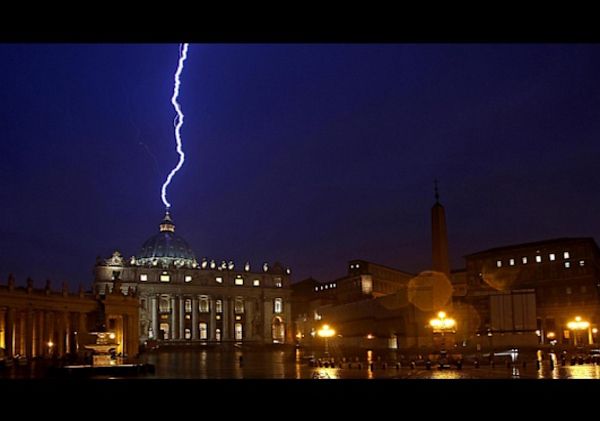
One hundred and fifteen cardinals will be locked up in the Vatican this afternoon. They’ll cast their first paper ballots for the next pope; and they’ll cast 2 more ballots every morning and 2 every afternoon from then on. Under Michelangelo’s magnificent Sistine Chapel ceiling, in front of the Last Judgement painted over the altar, they’ll return again and again. In their gorgeous red robes, under their pert red hats, they’ll keep casting their ballots until a 2/3s majority have the same name written on them.
It wasn’t always such a civilized process. Once upon a time, papal elections were often contested, and papal factions were often armed. Some of those skirmishes are recorded in the Liber Pontificalis, or Book of the Popes, kept for hundreds of years by insiders at Rome. As early as 366, an aristocratic candidate, Damasus, who was the son of a priest, had it out with the people’s candidate, Ursinus. "Burning with superhuman desire for the good life," they armed gladiators, chariot drivers and gravediggers with hatchets; and Damasus got what he wanted—over 137 dead bodies.
There were other contested elections. After Boniface I (418-422) and an antipope, Eulalius (418-419) started another armed conflict, they got thrown out of Rome by the city prefect; and after Symmachus (498-514) and the antipope, Laurentius (498-506) took to the streets, members of the senate stripped nuns of their clothing and beat them, or killed priests. John I (523-526) gave up the ghost in a Gothic prison; Boniface II (530-532) ran in with another antipope, Dioscorus (530), and there was “strife among the clergy and in the senate” for 28 days before Dioscorus died; Silverius (536-537) was dispatched to the island of Palmaria where, “fed with the bread of tribulation and the water of bitterness,” he breathed his last; Vigilius (537-555) got dragged through the streets of Constantinople with a rope around his neck, then put under house arrest, and died on his way home to Rome; Martin I (649-655) was deposed, smuggled out of Rome, and locked up in Contantinopolitan prisons for 178 days before he passed away on the Crimean Sea; Sergius I (687-689) stormed the Lateran gates and threw the antipopes Theodore (687) and Paschal (687) out; after more street fights, Stephen III (768-772) had the antipopes, Constantine (767-768) and Philip (768), condemned to lifelong penitence as monks; Leo III (795-816) was left blind and dumb in the road before Charlemagne came along to rescue him; John VIII (872-882) got struck with a hammer till his skull was bashed in; Stephen VI (896-897) was imprisoned and strangled by another Roman faction—after having dug up his predecessor’s corpse, set it on St Peter’s chair, cut 3 fingers off its right hand, and thrown the rest into the Tiber (“how wrong his conduct was”); John X (914-928) was suffocated with a pillow in the Castel Sant’Angelo; John XII (955-964) got caught in bed with another man’s wife, and dealt such a violent blow on the temples that he died in a week; Benedict V was beaten with the papal scepter, and died in Hamburg; Benedict VI (964-966) got strangled in the Castel Sant’Angelo; John XIV (983-984) was stuck in a Castel Sant’Angelo dungeon and starved; the body of the antipope, Boniface VII (984-985) got stripped, stabbed and thrown under Marcus Aurelius’ statue; antipope John XVI (997-998) got set backward on an ass and led through the streets of Rome, with his eyes put out, and his nose, lips and tongue cut off; Clement II (1046-1047), Damasus II (July-August 1048) and Stephen IX (1057-1058) are all supposed to have been poisoned; the antipope Benedict X (1058-1059), surrounded by hordes of armed men, was run out of Rome, then bit the dust as a prisoner in the hospice of Sant’Agnese; and when pope Alexander II (1061-1073) ran in with the antipope Cadalus of Parma (1061-1072) they set up camp in the field of Nero and left hundreds dead in the streets. Even when the great reformer, Gregory VII the Great (1073-1085), became a pope, his accession was ambiguous. The official record reported that cardinals, acolytes, subdeacons, deacons, presbyters, abbots, priests and monks, “amid the acclamations of vast crowds of both sexes and of various ranks,” had elected him pope. On the other hand, 7 years later, bishops at Holy Roman Emperor Henry IV’s council of Brixen convicted him of having “murdered 4 Roman pontiffs, with violent deaths,” first.
But my favorite story is about how the Wonder of the World, the Holy Roman Emperor Frederick II, surrounded the city with armies, then locked up a few cardinals in a decrepit old palace, the Septizodium, and asked them to pick a new pope in 1241. He told the guards on the next floor to use the ceiling to relieve themselves. That should have hurried them up, but the cardinals couldn’t come to a consensus. In the end, after a month, they made Goffredo Castiglioni, the cardinal priest of San Marco, the next pope, but being sick, old and poisoned, he was dead after just 17 days. And by then, there were just 6 or 7 cardinals left. “Some had been removed from this world, some were ill, and others were lying concealed with their friends and relations in distant parts,” reported the British historian and monk, Matthew Paris.
Lately, scandals have rocked the Roman Church. But scandals have always rocked the Roman Church. Money scandals. Scandals of sexual abuse. In so many ways, Catholics have cleaned up their acts. When the white smoke finally pours from the Vatican chimney, and the doors finally open on the Sistine Chapel, none of the cardinals is likely to have been suffocated, strangled or drugged. And outside in St Peter’s basilica, no blood is likely to have been shed.
PHOTO CREDIT
https://www.theguardian.com/world/video/2013/feb/12/lightning-vatican-p…
References
Duffy, Eamon. 2006. Saints and Sinners: A History of the Popes. New Haven: Yale University Press.
Kelly, J. N. D. 2010. Oxford Dictionary of the Popes. London: Oxford University Press.


